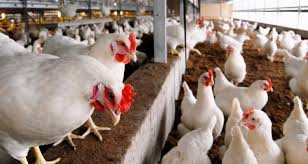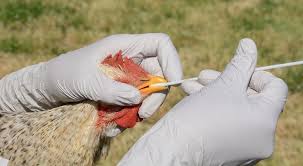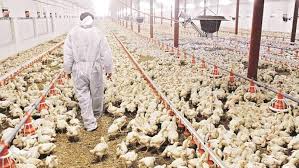Avian influenza, commonly known as bird flu, is a viral infection that affects birds, particularly wild waterfowl like ducks and geese, as well as domestic poultry such as chickens and turkeys. The scientific name for this infectious disease is Influenza A virus subtype H5N1.
Bird flu is caused by the H5N1 virus, and it can spread easily among birds through their saliva, nasal secretions, and feces. While wild birds are natural carriers of the virus, they usually don’t get sick from it. However, when the virus infects domestic poultry, it can result in severe illness and often leads to high mortality rates in affected flocks.
One of the concerning aspects of avian influenza is its potential to transmit from birds to humans. In rare cases, people can contract bird flu when they come into close contact with infected birds or their environments. The transmission to humans raises public health concerns due to the possibility of a global pandemic if the virus were to mutate into a form easily transmissible among humans.
Symptoms of bird flu in humans can range from mild to severe and may include fever, cough, sore throat, muscle aches, and respiratory distress. In severe cases, the infection can lead to pneumonia and, in some instances, be fatal. Due to the seriousness of the disease and its potential impact on human health, monitoring and controlling the spread of avian influenza are crucial.
Efforts to prevent bird flu involve measures such as culling infected poultry, practicing good hygiene in poultry farms, and monitoring and regulating the international trade of live birds and poultry products. Additionally, vaccination programs for domestic poultry aim to reduce the risk of the virus spreading.
Global health organizations, governments, and veterinary authorities collaborate to monitor and respond to outbreaks of avian influenza. Early detection, rapid response, and effective communication are vital components of controlling the spread of the virus and minimizing its impact on both animal and human health.
Additionally, avian influenza, or bird flu, is a viral infection that primarily affects birds, with the potential to transmit to humans. The scientific name for the virus is Influenza A virus subtype H5N1. While wild birds are natural carriers, the infection in domestic poultry can be severe and result in high mortality rates. Monitoring, prevention, and control measures are essential to mitigate the risks associated with avian influenza and protect both animal and human populations.
Read Also: Guide to Milk Production, Composition, and Nutritional Value of Milk
Animals Affected by Avian influenza (bird flu)

Avian influenza, commonly known as bird flu, primarily affects birds, both wild and domestic. The virus has a strong affinity for avian species, and different strains of the influenza A virus can cause varying degrees of illness in different types of birds.
1. Wild Birds: Wild waterfowl, particularly ducks and geese, are natural reservoirs for avian influenza viruses. These birds often carry the virus without showing signs of illness. Other wild bird species can also become infected, and they play a significant role in the spread of the virus, especially during migratory seasons.
2. Domestic Poultry: Avian influenza has a substantial impact on domesticated birds, including chickens, turkeys, and ducks. Infected poultry may exhibit a range of symptoms, from mild illness to severe respiratory distress. In outbreaks, the virus can spread rapidly among flocks, leading to economic losses in the poultry industry.
3. Birds of Prey: Birds of prey, such as eagles and hawks, can be affected by avian influenza if they come into contact with infected birds. However, these cases are relatively rare.
4. Mammals: While avian influenza primarily targets birds, there have been instances of mammals, including humans, contracting the virus. Transmission to mammals is uncommon and often requires close contact with infected birds. Human cases are usually associated with handling infected poultry or being in environments contaminated with the virus.
It’s important to note that the susceptibility to avian influenza varies among bird species. Some birds may carry the virus without developing symptoms, while others may experience severe illness. Additionally, the potential for transmission to mammals, including humans, underscores the importance of monitoring and implementing preventive measures to reduce the risk of a broader outbreak and protect both animal and human health.
Damages Caused by Avian Influenza (bird flu)
Avian influenza, or bird flu, can result in various damages with significant economic, health, and environmental impacts. The damages caused by avian influenza include:
1. Economic Losses in Poultry Industry: One of the most notable damages is the economic impact on the poultry industry. Infected birds in domestic poultry flocks often lead to high mortality rates and decreased egg production. The culling of infected birds and trade restrictions can result in substantial financial losses for poultry farmers and related industries.
2. Trade Disruptions: The identification of avian influenza in poultry can lead to trade restrictions and bans on the export of live birds and poultry products. This can have severe economic consequences for countries heavily reliant on poultry exports.
3. Culling and Depopulation Costs: To control the spread of the virus, infected birds and those at risk of infection are often culled or depopulated. The costs associated with culling, disposal of carcasses, and cleaning and disinfection of affected areas contribute to the economic burden.
4. Human Health Impact: While rare, human cases of avian influenza can occur. The potential for the virus to transmit from birds to humans raises concerns about public health. Severe cases in humans can lead to hospitalizations, intensive medical care, and in some instances, fatalities.
5. Impact on Food Security: The loss of poultry production due to avian influenza can affect food security, as poultry is a significant source of protein for many populations. Reductions in poultry availability may lead to higher prices and limited access to this essential food source.
6. Environmental Contamination: Infected birds shed the virus in their saliva, nasal secretions, and feces. This environmental contamination can contribute to the spread of the virus and make control measures more challenging. It also poses risks to other wildlife that may come into contact with contaminated areas.
7. Disruption of Ecosystems: Avian influenza can impact wild bird populations, particularly those involved in migratory patterns. The virus can spread through the movement of infected wild birds, potentially disrupting ecosystems and biodiversity.
Addressing the damages caused by avian influenza requires coordinated efforts in surveillance, prevention, and control measures. These efforts involve collaboration between governments, veterinary authorities, public health agencies, and the poultry industry to minimize economic losses, protect public health, and safeguard both domestic and wild bird populations.
Read Also: Understanding Milk Quality and Quality Characteristics of Milk
Control and Preventive Measures

Controlling and preventing the spread of avian influenza (bird flu) involves a combination of measures aimed at both domestic poultry and wild bird populations. Here are key control and preventive measures:
1. Surveillance and Monitoring: Implement regular monitoring of bird populations, especially in areas with known bird flu prevalence. Enhance surveillance at farms, live bird markets, and areas where wild birds congregate.
2. Biosecurity Practices: Establish and enforce strict biosecurity measures on poultry farms to prevent the introduction and spread of the virus. Control access to farms, and implement measures such as disinfection, proper waste disposal, and hygiene protocols.
3. Vaccination Programs: Implement vaccination programs for domestic poultry to reduce the risk of infection and mitigate the severity of the disease. Develop and use vaccines that are effective against prevalent strains of avian influenza.
4. Culling and Depopulation: Swiftly cull infected poultry and those at risk of infection to prevent further spread. Implement proper disposal methods for culled birds to minimize environmental contamination.
5. Quarantine Measures: Enforce quarantine measures for infected and at-risk farms to prevent the movement of birds and reduce the risk of transmission. Restrict the movement of poultry and related products in affected areas.
6. Public Awareness and Education: Educate farmers, poultry workers, and the general public about the risks of avian influenza and the importance of reporting sick birds. Promote awareness of proper hygiene practices to reduce the risk of human transmission.
7. International Cooperation: Collaborate with neighboring countries and international organizations to share information and coordinate efforts in preventing and controlling avian influenza.
Establish mechanisms for early reporting and rapid response to outbreaks.
8. Wildlife Management: Monitor and study wild bird populations to better understand the dynamics of avian influenza in the wild.
Implement measures to reduce the risk of transmission between wild and domestic birds, especially in areas where they may come into contact.
9. Research and Development: Invest in research to develop more effective vaccines, diagnostic tools, and antiviral medications.
Enhance understanding of the virus’s behavior and its potential to evolve.
10. Legislation and Regulation: Develop and enforce regulations that govern the movement, trade, and handling of live birds and poultry products. Implement penalties for non-compliance with biosecurity measures and reporting requirements.
By combining these measures, authorities can work towards minimizing the impact of avian influenza, protecting both animal and human health, and maintaining the stability of the poultry industry. Timely and coordinated actions are crucial in preventing the spread of the virus and mitigating its consequences.
Frequently Asked Questions (FAQs) About Avian Influenza (bird flu)
Q1: What is avian influenza?
A: Avian influenza, commonly known as bird flu, is a viral infection that primarily affects birds, both wild and domestic. It is caused by the Influenza A virus subtype H5N1 and can pose risks to human health.
Q2: How is avian influenza transmitted?
A: The virus is usually spread among birds through their saliva, nasal secretions, and feces. In some rare cases, it can transmit from birds to humans through close contact with infected birds or contaminated environments.
Q3: Which birds are most susceptible to avian influenza?
A: Wild waterfowl, particularly ducks and geese, are natural carriers of the virus. Domestic poultry, including chickens and turkeys, are also highly susceptible to avian influenza.
Q4: What are the symptoms of avian influenza in birds?
A: Infected birds may show a range of symptoms, including respiratory distress, reduced egg production, and high mortality rates. However, wild birds often do not exhibit noticeable symptoms.
Q5: Can humans get avian influenza?
A: While rare, humans can contract avian influenza, especially through close contact with infected birds. Human cases may present with flu-like symptoms and, in severe cases, lead to pneumonia and respiratory distress.
Q6: How is avian influenza diagnosed in birds?
A: Diagnosis involves laboratory testing of bird samples, such as blood or swabs from the respiratory and digestive tracts. Rapid and accurate diagnosis is crucial for implementing control measures.
Q7: Can avian influenza be prevented in domestic poultry?
A: Prevention measures include strict biosecurity practices on farms, vaccination programs, and prompt culling of infected birds. These measures aim to minimize the risk of introduction and spread of the virus.
Q8: What should I do if I suspect avian influenza in my flock?
A: Immediately report any signs of illness in birds to veterinary authorities. Quarantine affected birds, follow biosecurity protocols, and avoid the movement of birds or poultry products.
Q9: Is it safe to consume poultry products during avian influenza outbreaks?
A: Properly cooked poultry products are safe to consume. Cooking temperatures kill the virus. However, it’s crucial to follow recommended hygiene practices when handling and preparing poultry.
Q10: How can international cooperation help in controlling avian influenza?
A: International collaboration enables the sharing of information, resources, and coordinated responses to outbreaks. This helps prevent the global spread of the virus and enhances collective efforts in monitoring and control.
Read Also: Complete Composting Guide for Beginners

